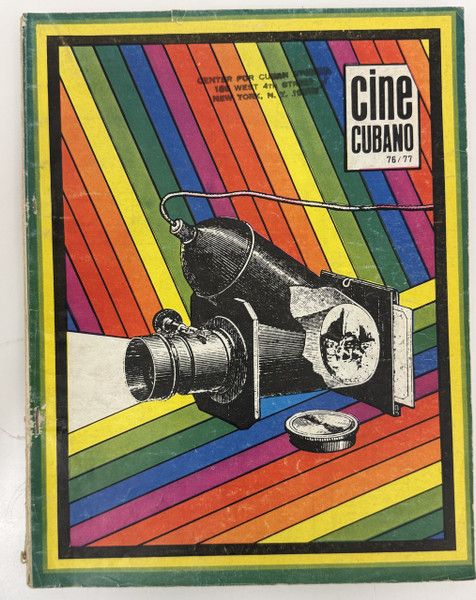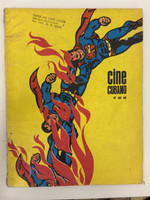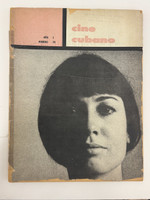- Travel
-
Exhibits
- La Portada Cubana
- Immortal Cuba: Artists Take on Their Heroes
- Seattle Poster Exhibit
- Sandra Dooley & Alejandrina Cué
- The Art of Wayacón
- Cuban Folk Art
- Cuba In Black And White
- 25 Years of Cuban Art Space
- Summer Folk Art Expo
- ¡SPRING AWAKENING FROM CUBA!
- Celebrating The Art Of Cuban Women
- Celebrating Paper, Affordable Art from Cuba
- Art of the Revolution
- Outsider Art
- Lost and Found
- En la lucha: Celebrating Cuban Women and Their Art
- Cuban Art Stash
- 100 Fires: 5 Cienfuegos Artists' Work on Paper
- Waya + Monte! Magic Realism in Cienfuegos
- Viva Cuba Viva! Poster Show
- Cultivando Sueños
- Black Lives Matter in Cuba Jan 9-March 27
- Leandro Soto: Crónicas visuales
- Cuban Canvas
-
Archive
- Global Reflection 2018: Spirit and Community
- Exhibit in the cloud: Contemporary Works on Paper
- MADE IN CUBA! MINNEAPOLIS EXHIBIT
- Cuban Posters and Photography from CCS collection
- AUTUMN SALE! Sept/Oct 2017
- SPRING ARTS AND CRAFT SALE
- Vuelo Directo/Non Stop: Alberto & Alejandro Lescay
- The Many Faces of Fidel
- Somos
- Made in Cuba!
- The US empire in Cuban graphics
- Made in Cuba/Seattle exhibit
- Entre Nos
- Looking Back
- Cuban Art Space
- Membership/Donate
- About Us
- Cuba News
-
The cover of "Cine Cubano" issues 76/77 presents Reboiro's exuberant design featuring a detailed engraving of a vintage film camera set against vibrant diagonal stripes in rainbow colors - yellows, oranges, reds, blues, greens, and purples - creating a dynamic sense of movement and celebration. The classical engraving style of the camera contrasts beautifully with the contemporary psychedelic color scheme, suggesting both cinema's historical foundations and its revolutionary potential. Holbein's layout maintains clean typography while allowing the explosive color field to dominate, reflecting the magazine's continued commitment to sophisticated visual presentation during the mid-1970s period of increased international cultural exchange and Third World cinema solidarity.
This double issue demonstrates Cuban cinema criticism's mature engagement with Latin American film movements during a period of heightened regional cooperation and revolutionary cinema development. The lead feature "La experiencia boliviana" by renowned filmmaker Jorge Sanjinés provides comprehensive analysis of Bolivian cinema's development from its early stages through its emergence as a significant force in Third World filmmaking. Sanjinés, director of influential films like "Yawar Mallku" and "El coraje del pueblo," offers insider perspective on the challenges and achievements of creating revolutionary cinema in Bolivia, discussing both the technical and ideological dimensions of anti-imperialist cultural production.
Published by the Instituto Cubano del Arte e Industria Cinematográficos under Alfredo Guevara's continued leadership, this issue includes extensive coverage of Continental and Third World cinema movements, analysis of films by Miguel Torres, discussions of Colombian cinema with focus on directors like Julio García Espinosa, interviews with Oscar Collazos, and examination of Cuban films including "Viva la República." Contributors including José Wainer, Carlos Alvieri, Fernando Pérez, Manuel Octavio, and Alexandar Medvedkin provide diverse perspectives on revolutionary cinema's development across Latin America. The editorial offices at Calle 23 no. 1155, Habana, Cuba, maintained subscription accessibility (0.25 pesos per issue in Cuba, 2.75 annual in Cuba, 5.00 international) while facilitating crucial dialogue about anti-imperialist cinema during this pivotal period of Third World cultural solidarity and revolutionary film practice.
-
-
Discover More at the Center for Cuban Studies





![Instituto Cubano del Arte e Industria Cinematográficos / ICAIC (director: Alfredo Guevara), "Cine Cubano" issue 48 - "Cine del Tercer Mundo," [1970s]. Offset print, magazine.](https://cdn10.bigcommerce.com/s-ufzvo/products/5901/images/6486/IMG_8812__28936.1761537538.200.200.jpg?c=2)
![Instituto Cubano del Arte e Industria Cinematográficos / ICAIC (layout: Holbein, cover design: Reboiro (Antonio Fernández Reboiro), director: Alfredo Guevara), "Cine Cubano" issues 78/79/80, [1978-1980]. Offset print, magazine.](https://cdn10.bigcommerce.com/s-ufzvo/products/5904/images/6491/IMG_8819__36889.1761600195.200.200.jpg?c=2)
![Instituto Cubano del Arte e Industria Cinematográficos / ICAIC (layout: Holbein, cover design: Tony Fernández Reboiro, director: Alfredo Guevara), "Cine Cubano" issues 54-55, [1969]. Offset print, magazine.](https://cdn10.bigcommerce.com/s-ufzvo/products/5905/images/6493/IMG_8821__07256.1761600194.200.200.jpg?c=2)